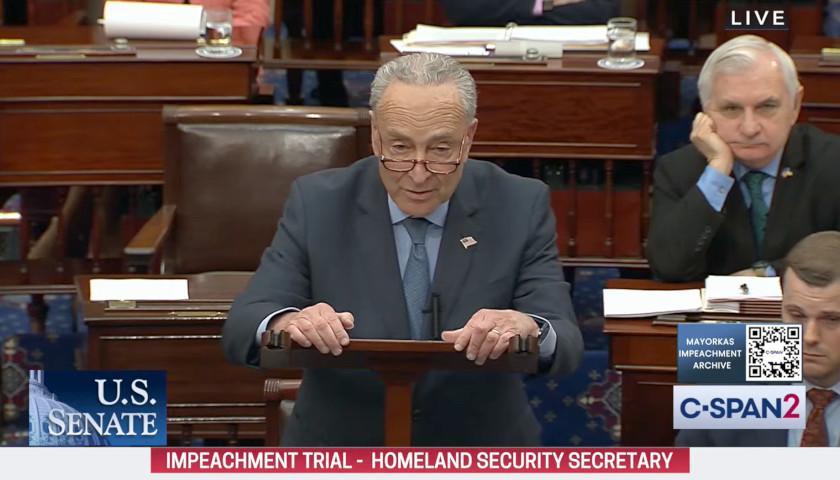by Henry Olsen
Senator Sherrod Brown is one of many Democrats considering a run for the White House. His name likely does not ring a bell, as he has not garnered the national attention that other potential rivals have. Many observers think he could be a formidable opponent for President Trump should he gain the Democratic nomination. The evidence, however, suggests that might be easier said than done.
The case for Brown starts—and often stops—with his long courting of Ohio’s working-class voters, usually with favorable results. He has doggedly opposed free trade deals throughout his Senate career, even leading the effort to defeat the Central American Free Trade Association (CAFTA) during the Bush Administration. A consistent ally of Bernie Sanders (I-Vt.) in the Senate, Brown’s economic populism nevertheless stems from a labor union rather than a doctrinaire social democratic outlook. That viewpoint, the argument goes, makes him a solid choice to battle Trump for the loyalties of the white working-class voter whose defection from the Democrats made Trump president.
That argument overlooks, however, Brown’s distinctly non-working-class views on nearly every other issue. Brown has one of the most progressive records in the Senate on a raft of issues, not just economic ones. He has long been an advocate of gun control, earning him an “F” rating from the NRA. He has also been a staunch backer of LGBT issues, opposing Ohio’s 2004 ballot initiative to ban same-sex marriage. Named one of the Senate’s most liberal members in 2011 by the nonpartisan National Journal, Brown is a progressive’s progressive.
Brown would also easily be cast as a creature of the political swamp. He first won elected office as a 22-year-old in 1974, and has served in public office ever since save for one two year span after he was defeated for re-election in 1990. Brown literally came home after he graduated from Yale, ran for office, and has been pulling a public paycheck ever since.
Blue-collar voters overlooked all of this in in the pre-Trump years, but moved decisively away from Brown in this year’s Senate race. Brown only won less than seven percentage points, despite running against a weak opponent, Rep. Jim Renacci, who was abandoned by the national party and could not afford to run television ads until the final weeks of the race. Renacci won among whites without a college degree by a 55-45 percent margin, a large improvement over 2012 Republican nominee Josh Mandel’s showing. Counties dominated by these voters, the same places that swung dramatically in Trump’s favor in 2016, also moved decisively against Brown compared with his 2012 re-election bid. If Brown couldn’t hold these voters against a weak opponent, he surely won’t do well among them against Trump.
Brown’s margin was as large as it was only because of dramatic improvements among suburban, well-to-do voters. In 2012, the exit poll showed Brown lost by thirteen points among the 21 percent of Ohio voters making $100,000 or more. This year, Brown won by four points among these same voters, whose share of the electorate rose to 29 percent. That seventeen percent shift accounted for nearly nearly five points of his seven point margin. Surely the Democrats do not need someone with Brown’s background to capture these voters in 2020.
Early polls of the Democratic presidential race show Brown trailing badly both nationally and in early states, rarely breaking 3 percent of the vote. Early polls rarely predict the final outcome, as at this stage they measure name identification more than genuine support. But it’s worth noting that Brown is an older, white male running for the nomination of a party increasingly dominated by younger, nonwhite, and female voters. Other candidates will share his progressive views on cultural and foreign policy issues, and candidates like Bernie Sanders and Elizabeth Warren (D-Mass.) share his passionate economic populism. Others may stumble, but without that happening it’s hard to see how Brown breaks through the pack.
Brown might be stronger as a vice presidential nominee than if he gains the top slot. He would balance the ticket if a woman is the nominee, and the fact he has been winning statewide elections in Ohio for over 30 years surely will force Republicans to spend resources to defend a state Trump must win to be re-elected.
Having Brown on the ticket could impel some blue-collar Midwestern whites to look again at the Democrats, and the margins in Michigan, Pennsylvania, and Wisconsin were so close that even a slight improvement could propel the Democrats to victory. That possibility alone should make Ohio Republicans regret giving Brown a pass when a stronger candidate could have beat him this year.
– – –
Henry Olsen is a senior fellow at the Ethics and Public Policy Center, a think tank in Washington D.C. He is also an editor at UnHerd.com where he writes about populism and politics around the world. He is the co-author, with Dante Scala, of The Four Faces of the Republican Party (Palgrave, 2015) and is the author of The Working Class Republican: Ronald Reagan and the Return of Blue-Collar Conservatism (HarperCollins, 2017).
Photo “Sherrod Brown” by Sherrod Brown.








